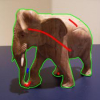Free Online Productivity Tools
i2Speak
i2Symbol
i2OCR
iTex2Img
iWeb2Print
iWeb2Shot
i2Type
iPdf2Split
iPdf2Merge
i2Bopomofo
i2Arabic
i2Style
i2Image
i2PDF
iLatex2Rtf
Sci2ools
CVPR
2010
IEEE
2010
IEEE
Geodesic Graph Cut for Interactive Image Segmentation
Interactive segmentation is useful for selecting objects of interest in images and continues to be a topic of much study. Methods that grow regions from foreground/background seeds, such as the recent geodesic segmentation approach, avoid the boundary-length bias of graph-cut methods but have their own bias towards minimizing paths to the seeds, resulting in increased sensitivity to seed placement. The lack of edge modeling in geodesic or similar approaches limits their ability to precisely localize object boundaries, something at which graph-cut methods generally excel. This paper presents a method for combining geodesicdistance information with edge information in a graphcut optimization framework, leveraging the complementary strengths of each. Rather than a fixed combination we use the distinctiveness of the foreground/background color models to predict the effectiveness of the geodesic distance term and adjust the weighting accordingly. We also introduce a spatially varying weigh...
Computer Vision | CVPR 2010 | Geodesic | Graph-cut Methods | This Paper Presents A Method For Combining Geodesicdistance |
| Added | 30 Mar 2010 |
| Updated | 14 May 2010 |
| Type | Conference |
| Year | 2010 |
| Where | CVPR |
| Authors | Brian Price, Bryan Morse, Scott Cohen |
Comments (0)

